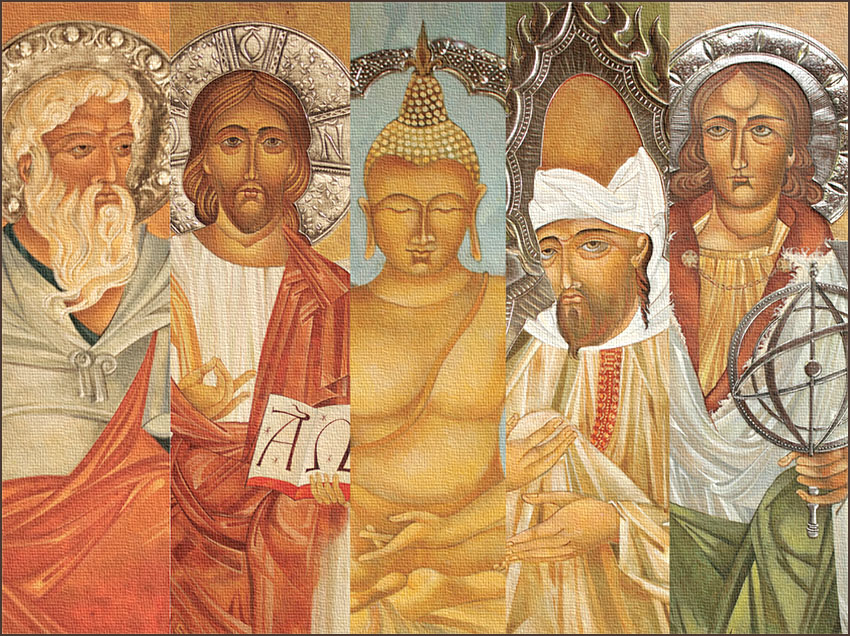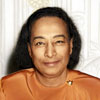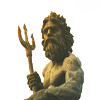Men of Miracles
 by Howard Murphet
by Howard Murphet
Most of us meet with the miraculous and magical in the tales of early childhood, and in those plastic years, before the “shades of the prison house” have begun to close around us, miracles are part of the accepted order. There is no incredibility, for example, in the magic power of Aladdin’s lamp, or in Jack’s beanstalk to the land of the giants, or in Christ walking over the storm-tossed water.
Such stories are not, of course, confined to the folklore and religious scriptures of the western world. The written chronicles of Man in all areas unroll a record of miracles that stretches from Lord Krishna, some 5,000 years ago, down to the present day. The Age of Miracles has always been with us. We read of its rosy morning on the far horizons of ancient Egypt, Chaldea, India and Palestine. And in the old Alexandria of the early Christian Era there were theurgists who at public ceremonies made statues “walk, talk and prophesy”.
In Europe during the Middle Ages the church unfortunately claimed a monopoly of the miraculous, and those who worked outside it had to work in secrecy. Such secular theurgical workers, belonging to the Rosicrucian and other brotherhoods of occult practice, did exist. However, and despite ecclesiastical power and jealousy, some great personalities – adepts like Paracelsus and the Comte de St. Germain – caught the attention of the public, stirring its cupidity, its fears and its suspicions.
But what actually do we regard as a miracle? If in those Middle Ages a single individual had appeared who could do any one of the many things we take for granted today – televise, travel through space above the earth, or to the moon, communicate in a few seconds with someone in another continent, convert matter into nuclear energy, or break matter down to its component atoms and use them like bricks to build an entirely different form of matter – what would have happened to such a dangerous heretic? What would they have done to one who thus flouted the laws of God, undermined the status of the theologians, and took unto himself the powers of angels? Would his life have been worth more than a bundle of faggots for burning? But these “miracles” around us today have come about gradually through the laborious efforts of science. We know some of the laws behind them. Or even if we don’t know the laws ourselves we believe that our modem priests, the technologists of science, do. And so we accept such phenomena comfortably and admiringly as the products of scientific progress. We don’t think of them as miracles.
Yet in a sense they are, just as the whole universe in space and time and the wondrous inventions of the mind are miracles. But provided we can say “It works according to such and such an equation,” or “Our scientists have discovered the laws, and our technologists operate according to them,” we feel that we are on safe ground. It is scientific; there is nothing magical about it.
So the definition of a miracle seems to be that it is a phenomenon concerning which we neither understand the causative laws ourselves, nor believe them to be understood by that large body of scientific workers in whom we put our trust and faith. Christian miracles such as those at Lourdes are, according to the theologians, “the suspension of the effect of a law of nature by God as its author”. But such an idea does not satisfy the occultist. According to him there is no suspension of law; there may appear to be, but actually the miraculous phenomenon is brought about by a deeper law, not yet discovered and enunciated by esoteric science. When the greater law is known our mental concept of the lesser one will be modified.
Madame H.P. Blavatsky stated the occult viewpoint thus, “A miracle is not a violation of the laws of nature, as is believed by ignorant people. Magic is but a science, a profound knowledge of the occult forces in nature and of the laws governing the visible or the invisible worlds.” Such occult laws are known to esoteric science, but those who possess such knowledge have always been few in number and not generally known to the public. So public opinion usually discounts their existence, and the existence of any esoteric body of knowledge.
Miracles, as found in the records, fall into a number of classes. Bhagavan Das, classifies the miraculous abilities of Lord Krishna as follows: (1) giving illuminating visions; (2) seeing at a great distance; (3) multiplying small amounts of food, or other material things, to create large quantities; (4) projecting his subtle body or bodies to appear simultaneously in several places at once; (5) healing the sick and deformed by a touch (6) on rare occasions bringing the “dead” to life; (7) laying dooms on particularly grievous sinners such as the one who murdered infants and sleepers.
Jesus Christ performed a similar wide range of miracles. But perhaps the emphasis was different. The Nazarene seems to have concentrated more on healing the sick, the maimed, and the insane. But he also performed much of what we now call “phenomena”; he levitated over the water, he made himself invisible; he multiplied food; he turned water to wine, he raised the “dead”. And, if the records are straight, his greatest phenomenal magic came at the end of the story. After death he dematerialised his body to bring it out of the tomb, rematerialised it into a plastic malleable form so that at times it was not recognisable by his disciples, and finally on the Mount of Olives he raised that etherialised body of earth to another plane of existence.
Krishna and Christ are the two outstanding miracle-workers of the world’s scriptures. But there have been many others of lesser stature, or sometimes perhaps merely of lesser fame. Some have been able to perform one or two classes of miracles; others have had power over many. The early Christian apostles could heal the sick and perform other wonders. Apollonius of Tyana, in the first century A.D., could do likewise, and more. Once his mere arrival in a town was sufficient to stop an epidemic of plague there. Many saints and mystics have shown miraculous powers such as levitation, bilocation or astral travel. Throughout the centuries there have been ample signs of a hidden brotherhood of occultists who were adepts in various branches of the High Magic.
In the latter half of the last century Madame H.P. Blavatsky startled an incredulous western world with a stream of inexplicable phenomena. Apparently – from nowhere she produced a variety of articles when needed – fruit, crockery, cutlery, jewellery, embroidered handkerchiefs, books, letters and other things. She is said to have converted one type of matter into another, to have travelled in her subtle body, and sometimes to have made her physical body invisible. She was able to see things from the past or from a great distance in what she called the astral “light”.
To anyone who studies the evidence thoroughly and without prejudice, there is no doubt that Madame Blavatsky was a genuine worker of what the world calls magic. Or perhaps it might he closer to the truth to say that in many cases the magic was done through her by certain highly-advanced yogis or adepts whose chela (disciple) she was.
It has been stated that she was a medium, but in its association with spiritualistic practice this word connotes loss of consciousness, and Madame Blavatsky never lost consciousness when phenomena were being performed through her. She preferred to use the word Mediator, rather than medium, in describing the part she played. The adepts who worked through her were living far away, but they were not limited by space; they were able to know what was happening at a distance and to take action – either through travel in subtle bodies or by some other means.
Towards so-called miracles, past and present, current public opinion may be said to fall into three categories. There are those (perhaps the majority in the western world) who say that miracle is all moonshine, that it has no basis in fact. There are, on the other hand, those who through personal experience or for some other reason accept the miraculous as quite factual. And finally there are some (a growing number) who keep an open mind on the question. They feel that events which are beyond the bounds of rational explanation are not necessarily beyond the bounds of possibility. They feel, indeed, rationality in the very idea that not all the laws and forces of the universe are yet stated in the textbooks of modern science.
But, while theoretically accepting the possibility of the miraculous, people of this third class are not convinced that miracles do in fact take place. Before accepting any event as miraculous, they need strong evidence, preferably the evidence of their own five senses, and even something more than that – an inner intuitive conviction that accompanies the seeing, the touching, the hearing, the testing.
An interest in psychic research, or parapsychology, and a study of its work over the last century had convinced me that many of the miracles were indeed steadily moving across the border into the territory of respectable scientific facts. Telepathy, clairvoyance and precognition are now established phenomena of the laboratories, though as yet there is no satisfactory explanation or scientific hypothesis for them. Furthermore, there is strong evidence for the reality of psychokinesis, the power of a man’s mind and will to move objects at a distance.
When such phenomena as the power to read minds, see through walls, foretell future events, or to mentally cause or change the motion of physical objects are becoming established beyond reasonable doubt through laboratory experiment and statistical analysis, we begin to have a scientific rationale behind what used to be called “magic”.
And that is what the majority need today, not a theological explanation as of old, but a rationale acceptable to the new “scientific” outlook even though many orthodox scientists turn their eyes away from the facts. In all ages there have been die-hard dogmatists who preferred the comfort of their own creeds or theories to new facts, new evidence, new thought. In all classes we find this inertia, this tamasic quality that clings to the safety of the status quo, eschewing the effort and hazards of the unending search for truth.
But if the “miraculous” really does take place, how does it operate? Can we know or discover something of the means and processes by which a so-called miracle is performed? Could a nuclear physicist explain to a primary schoolboy how a rocket is sent to the moon? He may give a few hints and an over-simplified explanation, but before the boy can really understand the laws and operations of nuclear physics he needs to develop his mental capacities and go, step by step, through a long, disciplined course of training.
The development and training required for a schoolboy to become a nuclear physicist is mainly one of intellect, concentration and perseverance. On the other hand, that needed for the ordinary human being to acquire some of the know-how of miracles is mainly one of character, psychic unfoldment and spiritual evolution. With true yogic training, which is in fact spiritual training, miraculous powers (siddhis) begin of themselves to make their appearance, as Patanjali points out in his Yoga Sutras. Many other great Teachers have taught the same law in various ways.
But what about the voodoo priests of Africa, the shamans of the Siberian Tribes, the witch-doctors of primitive peoples? Most of these are far from being spiritually evolved. In fact, the magical powers are often used by them for vengeance, personal gain, murder and various undetectable crimes.
This brings us to the question of the different levels of so-called magic – from the high white transcendental type, down through different shades of grey, to black magic or sorcery. Many kinds of miracles are worked through the co-operation of beings from other planes of existence, such as nature sprites, elementals, discarnate humans, and devas, or angelic beings. This theory seems to be the most widely held as it has been stated by practically all magicians, high and low, who have had anything to say on their modus operandi. Colonel H.S. Olcott, Founder-President of the Theosophical Society, states that the members of the last great school of theurgy, in old, Alexandria, “believed in elementary spirits whom they evoked and controlled”.
People of lower levels of spiritual evolution can apparently employ the technique of using these entities of the other planes of existence which interpenetrate the earth. But, as like always attracts like, sorcerers with evil motives will attract evil spirit agents to do their bidding. The power of such low-level magic is real enough under certain conditions, but is limited and fraught with danger to the practitioner. He must be ever on his guard lest his weapons boomerang and destroy him. This is one of the hazards of so-called black or left-hand magic.
Those who perform the grey or middle magic attract allies of a somewhat better type from the subtle planes of being. The motives of such magicians are not criminal. They don’t aim at murder, immorality, domination or destruction. Nevertheless, like the average citizen of today’s world, their motivation is more selfish than altruistic. Pride, desire for fame, ambition, and avarice are among the powers that move them. For example, Mohammed Bey, who earned a chapter in Paul Brunton’s book on India, was an average type of the grey magician. His aim was frankly to make money, and for his super-normal feats (mainly reading the contents of sealed documents) he had trained and was employing, he said, the discarnate spirit of his deceased brother. This is no more immoral and unethical, perhaps, than many normal commercial practices, such as the use of industrial spies “in the flesh”. But there may be more dangers involved, dangers to the health, well-being and integrity of the one who employs the discarnate forces. Moreover, miraculous powers used for commercial and selfish ends are easily lost, as many professional spiritualist mediums and Eastern pseudo-yogis have found out.
At the end of the scale from savage sorcery and black magic, through the various shades of grey, we come to the so-called white magic of the right-hand path. This is something entirely different. Different in motive, method, power and range. The key to its recognition lies in the motive. This must be pure; that is, entirely dissociated from the personal self of the miracle-worker. He must be one who has risen above the normal appeals of nature. Money, ambition, fame, personal power, security – the usual driving forces of man – must mean absolutely nothing to him. His only motivation is a pure love of his fellow men, with the wish to ease their sorrows and sufferings, and to lift them up to higher levels of understanding and happiness.
If a man has reached such lofty standards of action, perhaps through the evolution of many incarnations spent on earth, then miraculous powers will surely be his. They are part of his pure, divine nature. The Srimad Bhagavata asks: “What power is beyond the reach of the sage who has controlled his mind, senses, nerve currents and disposition; and concentrates on God?” And in another place it says: “When a person is merged in God, all powers, all knowledge, all wisdom, all perfection, which are termed divine, shine forth from such a person.”
All who have ever written on this difficult subject have said the same thing. Eliphas Levi wrote: “To command Nature man must be above Nature.” Joseph Ennemoser in his History of Magic, written over a century ago, said that divine miraculous works are possible only to those “who have converted their whole life into a divine one; who are no longer slaves to the senses…” And it is well-known that in the theurgic schools of old the hierophant who worked the esoteric mysteries lived a life of strictest purity and self-abnegation.
At the highest level we can say that “miracles” are the work of God coming through a purified person who incarnates (gives earthly human form to) Divinity. Christ said, “The father (God) that dwelleth in me, he doeth the works (miracles). I am in the father, and the father in me …”
In the Roman Empire of the first century A.D. sorcery had brought the whole of magic into disrepute and it was forbidden by the emperor. But the great miracle-man Apollonius of Tyana pointed out the differences between the lower and higher forms. He said, “Sacrifices have I no need of, for God is always present to me and fulfills my wishes … I call sorcerers false sages, for they are attracted only by riches which I have always despised…”
The divine miracle-workers have no need of the sacrifices and spellbinding enchantments used by magicians of a lower order. One does not read of Jesus or Krishna or Shirdi Baba employing tantric rites or chanting mantras. They were beyond the need of such formulae. The spiritual will was the creative power. Such a will is both human and divine. It is human in the sense that all men have it potentially, but what most men regard as their “will” is no more than their own desires, overt or hidden. Only as these selfish desires are eliminated, only as they are polished away like dirt from the surface of a crystal and man sees himself as one with God, only then does the true spiritual will shine forth. And this, being divine, has power and dominion over the worlds of matter.
That the universe runs according to a pattern of harmony and rhythm there can be no doubt. That Man, through careful observation and reasoning, has been able to make certain generalisations which he calls laws of nature, is equally true. But such generalisations never fully explain the phenomena of so-called magic. Time brings other generalisations, other hypotheses, other laws, which are closer to the ultimate truth; and in these the old “law” is swallowed up – shown to be either erroneous or only a partial understanding of reality.
The teachings of occult science, as given in Blavatsky’s The Secret Doctrine and other works, suggest that living beings beyond the atom; and as unseen as the atom is to human eyes, play a part in the workings of Nature. But such beings are not acting according to their own whims and caprices: they are working within, and helping to carry out, that rhythmic harmony which embraces the deepest laws of the universe. Nor does the miracle-worker divert such beings from their legitimate business and turn them into lawbreakers. Through his will they produce surprising effects, but this is still done according to law – though by a deeper law than man has yet uncovered. If we consider, for instance, that spectacular miracle, the converting of one class of matter into another, we may get some understanding of this principle. All matter, it is believed, emerges from energy and can be reconverted into energy. So the miraculous process is to reduce, one type of matter to its fundamental energy form, and from that build up another type of matter.
Even without reducing it to the basic nuclear energy, man is today converting one class of matter to another. For example, in the industrial complexes of synthetic chemical manufacture he is breaking down natural substances like coal and petroleum to their constituent elements and using these as building bricks to construct entirely new types of matter unknown to Nature – such as plastics and synthetic fibres. So what was once a lump of coal or a jar of petroleum becomes – a nylon dress, or perhaps a bright plastic housing for an electric razor.
Why then should there not be in the hidden laboratories capable of similar or even more difficult operations in reduction and conversion? Thus water becomes wine for a wedding feast in old Palestine, or oil for the lamps of a mosque at Shirdi. Such Masters will work according to cosmic laws. They cannot break laws any more than the wizards of modern chemistry can. But their controlling laws are deeper than the ones we yet know. According to these, and without upsetting Nature’s harmony, why should they not even convert base metals to gold when this is done under the will of a great alchemist who has lost all personal desire for gold, and who will use it only for the welfare of his fellow men? Considered on these lines, we see that the miracles of a Christ, a Krishna, any great Master of any century, are really no more incredible than the endless miracles forever around us “the starry worlds in time and space, the pageant of life, the processes of growth and reproduction”.
A full comprehension of the modus operandi of miracles is no doubt beyond the human consciousness in its present stage of evolution. But an attempt to solve such mysteries must lead us into a fuller understanding of ourselves and this magnificent universe about us.
Posted in Other Topics, Science For The New Agewith comments disabled.





